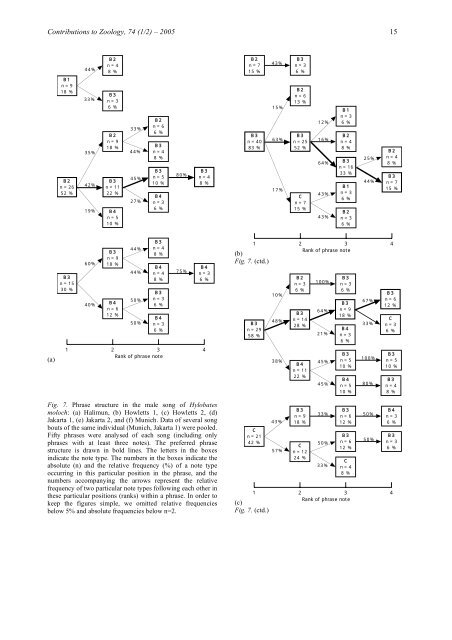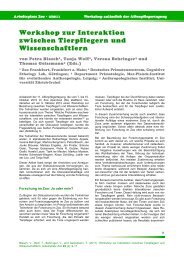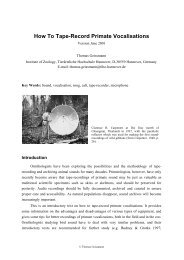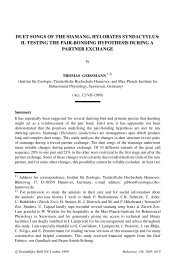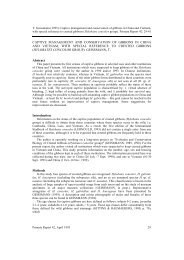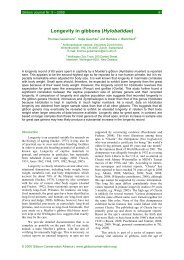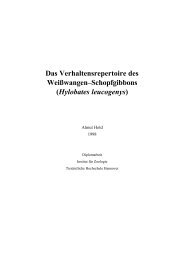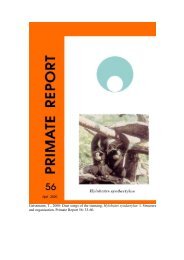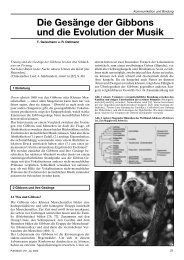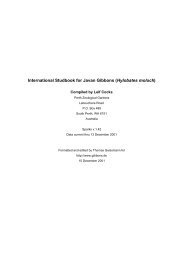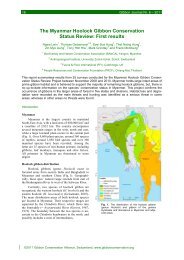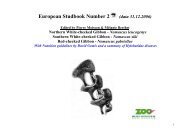14 T. Geissmann et al. – <strong>The</strong> Male Song <strong>of</strong> <strong>the</strong> <strong>Javan</strong> Silvery Gibbonand 5 correlations, respectively) than in <strong>the</strong> incompletelyrecorded <strong>song</strong>s <strong>of</strong> <strong>the</strong> Halimun, Jakarta1 and Jakarta 2 <strong>male</strong>s (1 significant correlationeach).As shown in Table 5, no two <strong>male</strong>s haveexactly <strong>the</strong> same note types among <strong>the</strong>ir set <strong>of</strong>significant correlations. Only five note typesexhibit matching correlations in two <strong>male</strong>s (i.e.A+B1, B3, C2, C combined, E), six note types aresignificant in only one <strong>male</strong> (C3, C4, C5, C6, C7,D) and three note types (B2, B4, C1) do notexhibit any correlation with <strong>song</strong> motivation.Phrase compositionTypical excerpts <strong>of</strong> <strong>the</strong> main phase <strong>of</strong> each studyanimal are shown in <strong>the</strong> sonagrams <strong>of</strong> Figure 6.<strong>The</strong> <strong>male</strong>s appear to differ strongly not only in <strong>the</strong>proportions <strong>of</strong> <strong>the</strong> various note types, but also in<strong>the</strong> structure <strong>of</strong> <strong>the</strong> phrases.In order to understand <strong>the</strong> sequential structure<strong>of</strong> note types in <strong>male</strong> phrases, we compared allphrases from <strong>the</strong> main <strong>song</strong> phase among allavailable <strong>song</strong> bouts as well as among individuals.Only phrases <strong>of</strong> at least 3 notes were included, andinspiration notes were ignored for this part <strong>of</strong> <strong>the</strong>kHz2a10101banalysis. <strong>The</strong> calculated note sequence probabilitiesfor each <strong>gibbon</strong> are shown in Figure 7.Data from multiple <strong>song</strong> bouts <strong>of</strong> <strong>the</strong> sameindividual were pooled.<strong>The</strong> Halimun <strong>male</strong> (Fig. 7a) begins 52% <strong>of</strong> hisphrases in <strong>the</strong> main <strong>song</strong> phase with a note <strong>of</strong> <strong>the</strong>type B2. This note is followed by a B3 note in42% <strong>of</strong> <strong>the</strong> cases, which is followed by two morenotes <strong>of</strong> <strong>the</strong> same type in succession. All o<strong>the</strong>rnote sequences also occurring in this <strong>male</strong>’sphrases only play a subordinate role.Male 1 from Howletts (Fig. 7b) begins 83% <strong>of</strong>his phrases with a note <strong>of</strong> <strong>the</strong> type B3. This note isfollowed by a B3 note in 63% <strong>of</strong> <strong>the</strong> cases, whichis followed, again, by two more notes <strong>of</strong> <strong>the</strong> sametype in succession. Male 2 from Howletts (Fig. 7c)exhibits <strong>the</strong> same preferred phrase structure, but<strong>the</strong> relative frequencies for each position in <strong>the</strong>phrase are less narrowly determined.<strong>The</strong> tape-recorded <strong>song</strong> bouts <strong>of</strong> <strong>the</strong> Jakarta 1<strong>male</strong> (Fig. 7d) reveal a much different preferredorder <strong>of</strong> phrase notes. <strong>The</strong> first note is <strong>of</strong> <strong>the</strong> B2note type in 59% <strong>of</strong> <strong>the</strong> cases, similar to <strong>the</strong>Halimun <strong>male</strong>. Unlike <strong>the</strong> phrases <strong>of</strong> any o<strong>the</strong>rstudy <strong>male</strong>, <strong>the</strong> first note is followed by a note <strong>of</strong>type B2 in 49% <strong>of</strong> all phrases (or – in 43% – bynote type C), followed by C and B3 in third andfourth positions, respectively.<strong>The</strong> Jakarta 2 <strong>male</strong> (Fig. 7e) starts 78% <strong>of</strong> allphrases with note type C and preferentially insertstype C in positions 2-5 <strong>of</strong> his phrases as well. This<strong>gibbon</strong> exhibits <strong>the</strong> most pronounced preferencefor note type C <strong>of</strong> all study <strong>male</strong>s. Moreover, <strong>the</strong>phrase structure <strong>of</strong> this <strong>male</strong> appears to be <strong>the</strong>least variable <strong>of</strong> <strong>the</strong> study <strong>male</strong>s and, <strong>the</strong>refore,01010101010cd0 2 4 6 8 10 12 14 16 skHz2e1010f1010g1Fig. 6. Representative excerpts from <strong>song</strong> bouts <strong>of</strong> <strong>silvery</strong><strong>gibbon</strong> <strong>male</strong>s, showing individual differences and low degree<strong>of</strong> stereotypy in <strong>song</strong> structure. All sonagrams stem from <strong>the</strong>main phase <strong>of</strong> <strong>song</strong> bouts. <strong>The</strong> individual <strong>male</strong>s are: (a)Halimun, (b) Howletts 1, (c) Howletts 2, (d) Jakarta 1, (e)Jakarta 2, (f) Kalejetan, (g) Munich.0100 2 4 6 8 10 12 14 16 sFig. 6. (ctd.)
Contributions to Zoology, 74 (1/2) – 2005 1544%B 2n = 48 %B 2n = 715 %43%B 3n = 36 %B 1n = 918 %B 2n = 2652 %33%35%42%19%B 3n = 36 %B 2n = 918 %B 3n = 1122 %B 4n = 510 %33%44%45%27%B 2n = 66 %B 3n = 48 %B 3n = 510 %B 4n = 36 %80%B 3n = 48 %B 3n = 4083 %15%63%17%B 2n = 613 %B 3n = 2552 %Cn = 715 %12%16%64%43%43%B 1n = 36 %B 2n = 48 %B 3n = 1633 %B 1n = 36 %B 2n = 36 %25%44%B 2n = 48 %B 3n = 715 %(a)B 3n = 1530 %60%40%B 3n = 918 %B 4n = 612 %44%44%50%50%B 3n = 48 %B 4n = 48 %B 3n = 36 %B 4n = 36 %75%B 4n = 36 %1 2 3 4Rank <strong>of</strong> phrase note1 2 3 4Rank <strong>of</strong> phrase note(b)Fig. 7. (ctd.)B 3n = 2958 %10%48%38%B 2n = 36 %B 3n = 1428 %B 4n = 1122 %100%64%21%45%45%B 3n = 36 %B 3n = 918 %B 4n = 36 %B 3n = 510 %B 4n = 510 %67%33%100%80%B 3n = 612 %Cn = 36 %B 3n = 510 %B 3n = 48 %Fig. 7. Phrase structure in <strong>the</strong> <strong>male</strong> <strong>song</strong> <strong>of</strong> <strong>Hylobates</strong><strong>moloch</strong>: (a) Halimun, (b) Howletts 1, (c) Howletts 2, (d)Jakarta 1, (e) Jakarta 2, and (f) Munich. Data <strong>of</strong> several <strong>song</strong>bouts <strong>of</strong> <strong>the</strong> same individual (Munich, Jakarta 1) were pooled.Fifty phrases were analysed <strong>of</strong> each <strong>song</strong> (including onlyphrases with at least three notes). <strong>The</strong> preferred phrasestructure is drawn in bold lines. <strong>The</strong> letters in <strong>the</strong> boxesindicate <strong>the</strong> note type. <strong>The</strong> numbers in <strong>the</strong> boxes indicate <strong>the</strong>absolute (n) and <strong>the</strong> relative frequency (%) <strong>of</strong> a note typeoccurring in this particular position in <strong>the</strong> phrase, and <strong>the</strong>numbers accompanying <strong>the</strong> arrows represent <strong>the</strong> relativefrequency <strong>of</strong> two particular note types following each o<strong>the</strong>r in<strong>the</strong>se particular positions (ranks) within a phrase. In order tokeep <strong>the</strong> figures simple, we omitted relative frequenciesbelow 5% and absolute frequencies below n=2.Cn = 2142 %1 2 3 4Rank <strong>of</strong> phrase note(c)Fig. 7. (ctd.)43%57%B 3n = 918 %Cn = 1224 %33%50%33%B 3n = 612 %B 3n = 612 %Cn = 48 %50%50%B 4n = 36 %B 3n = 36 %


